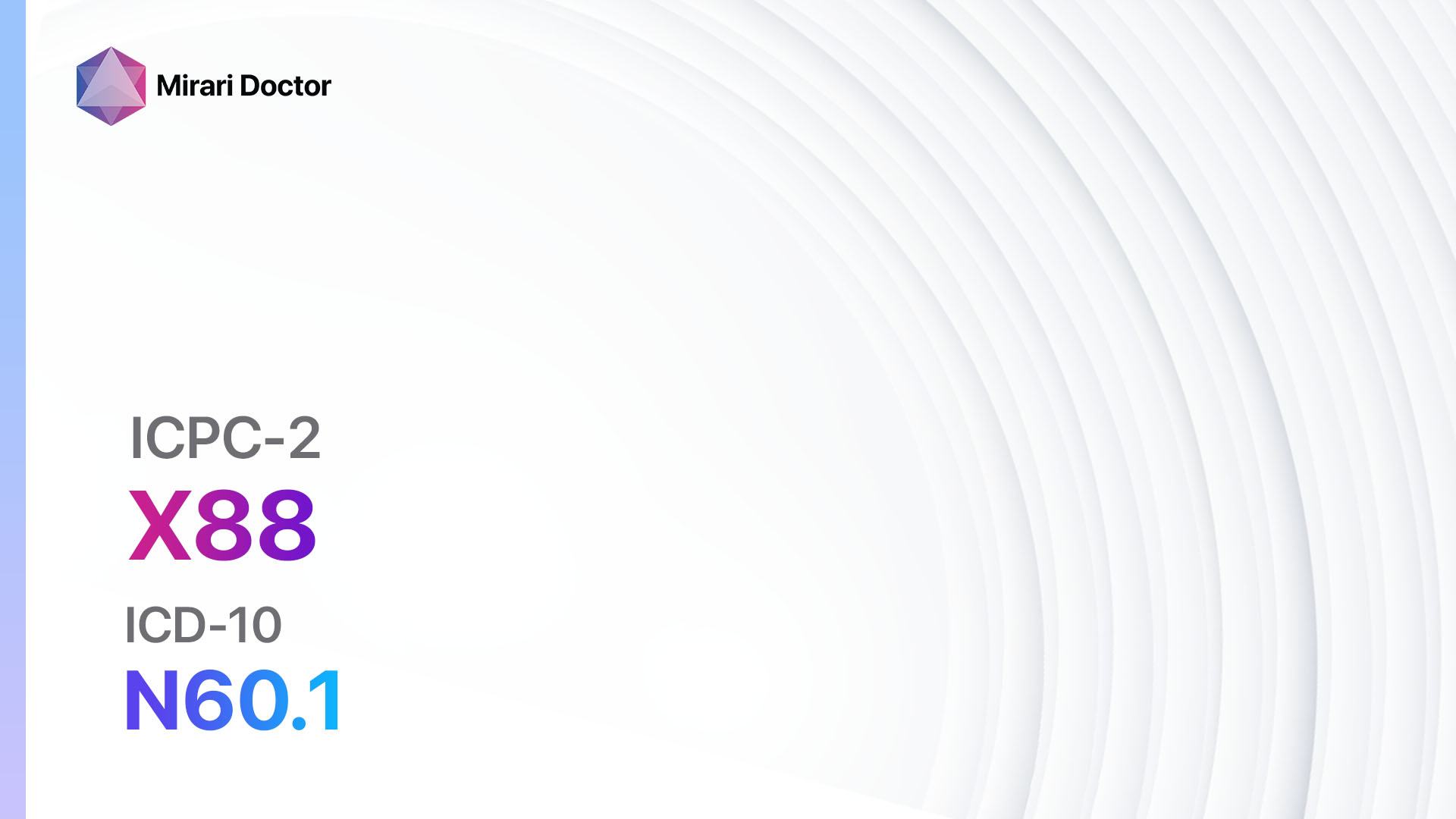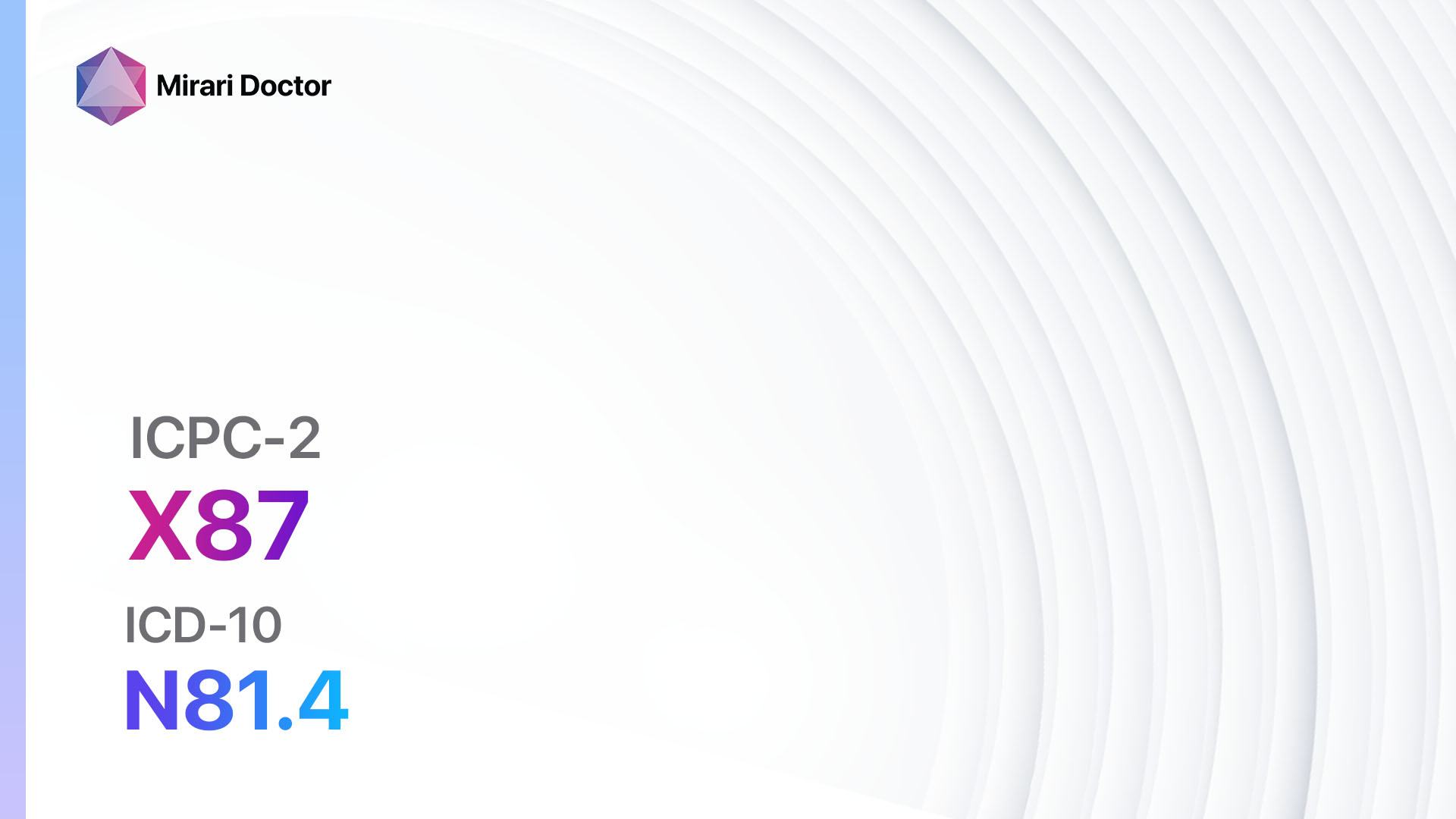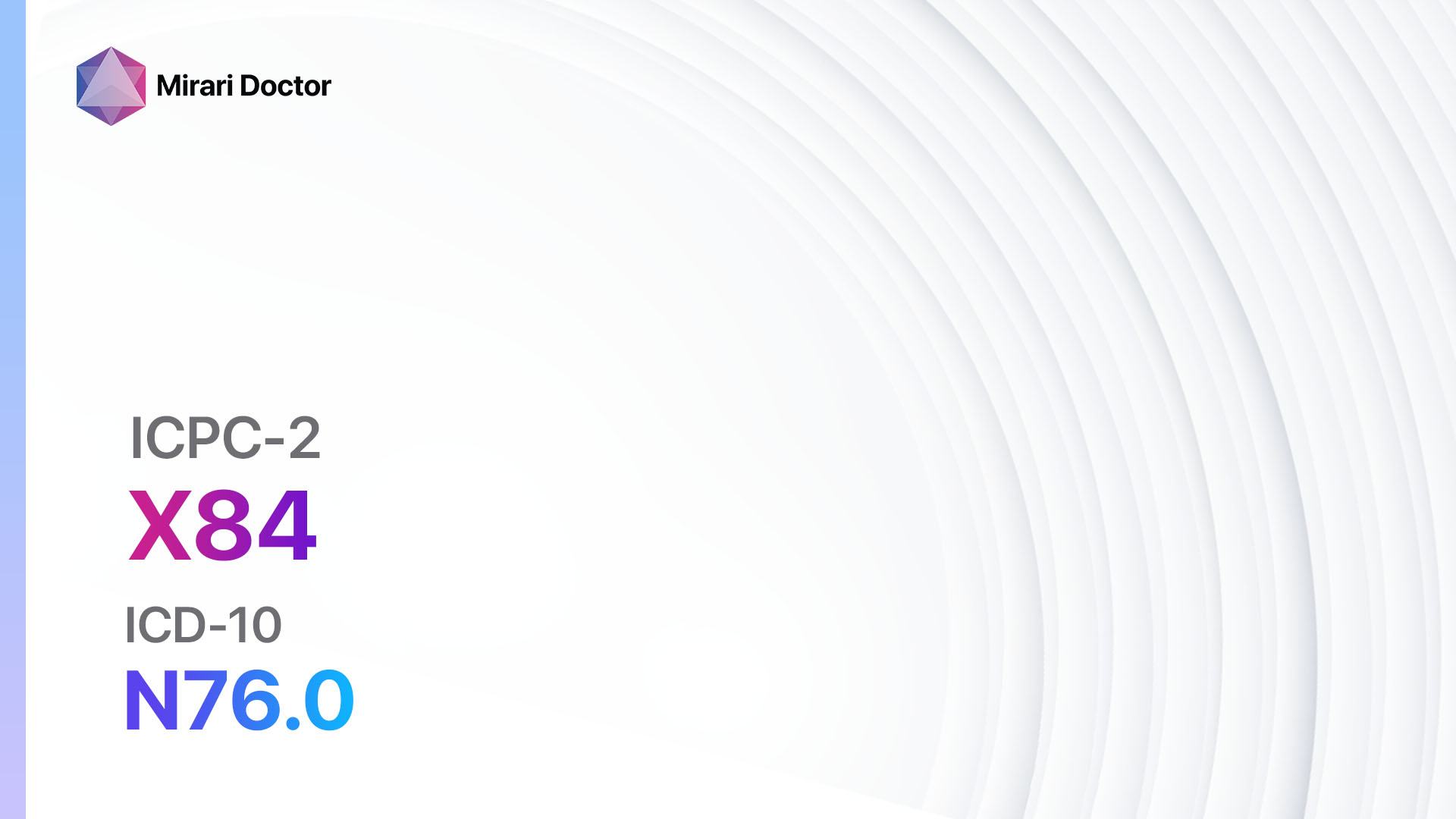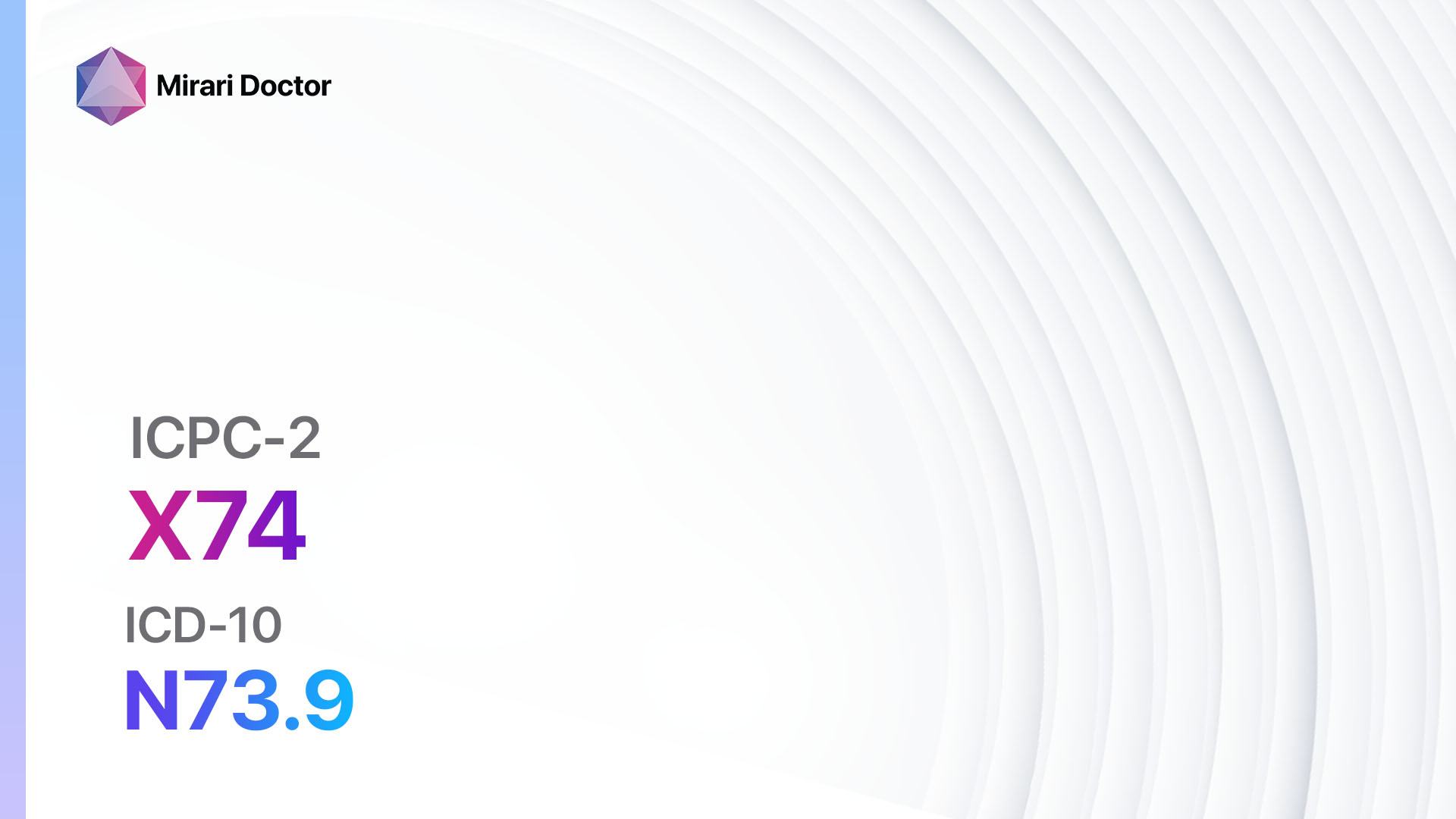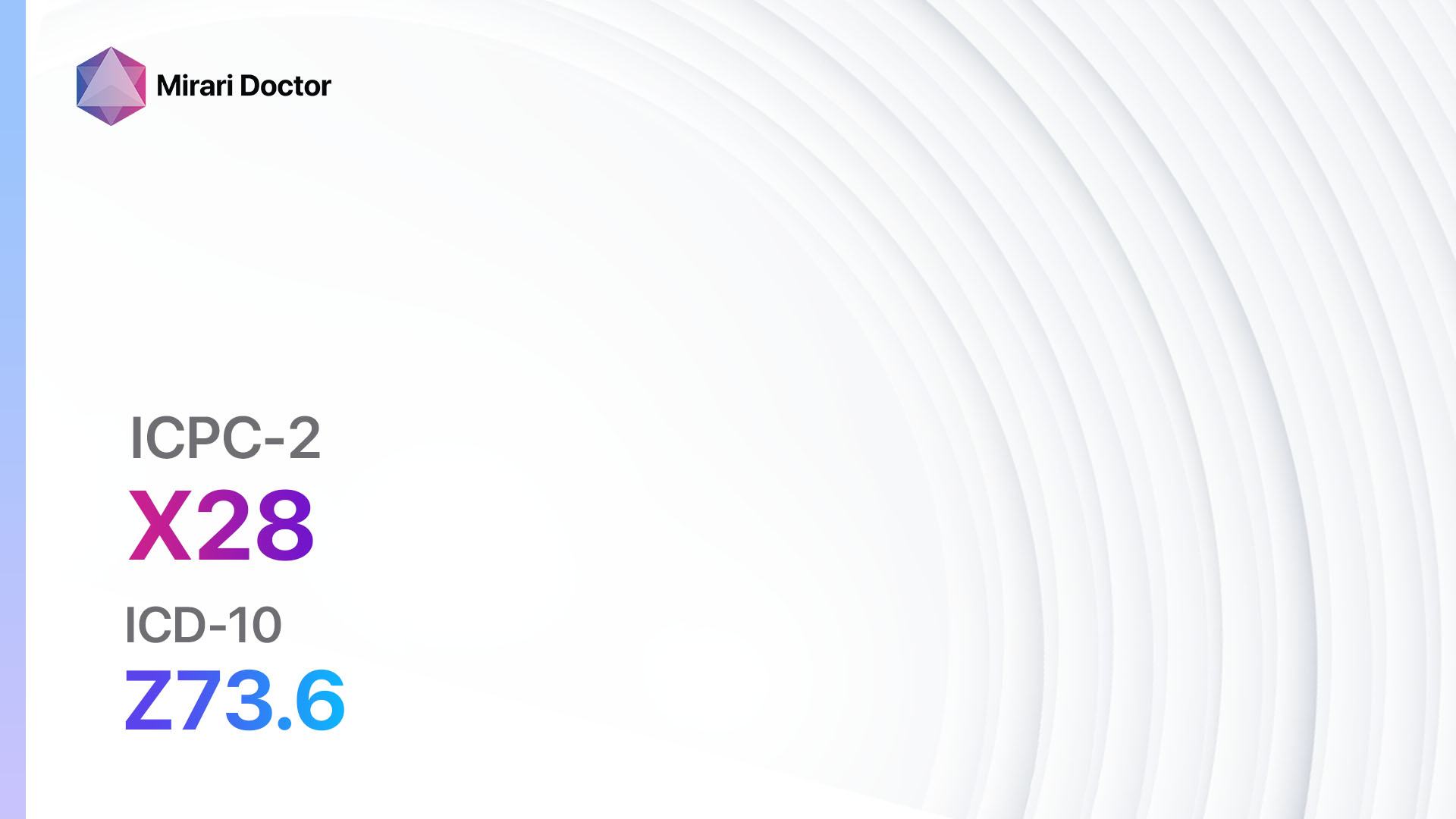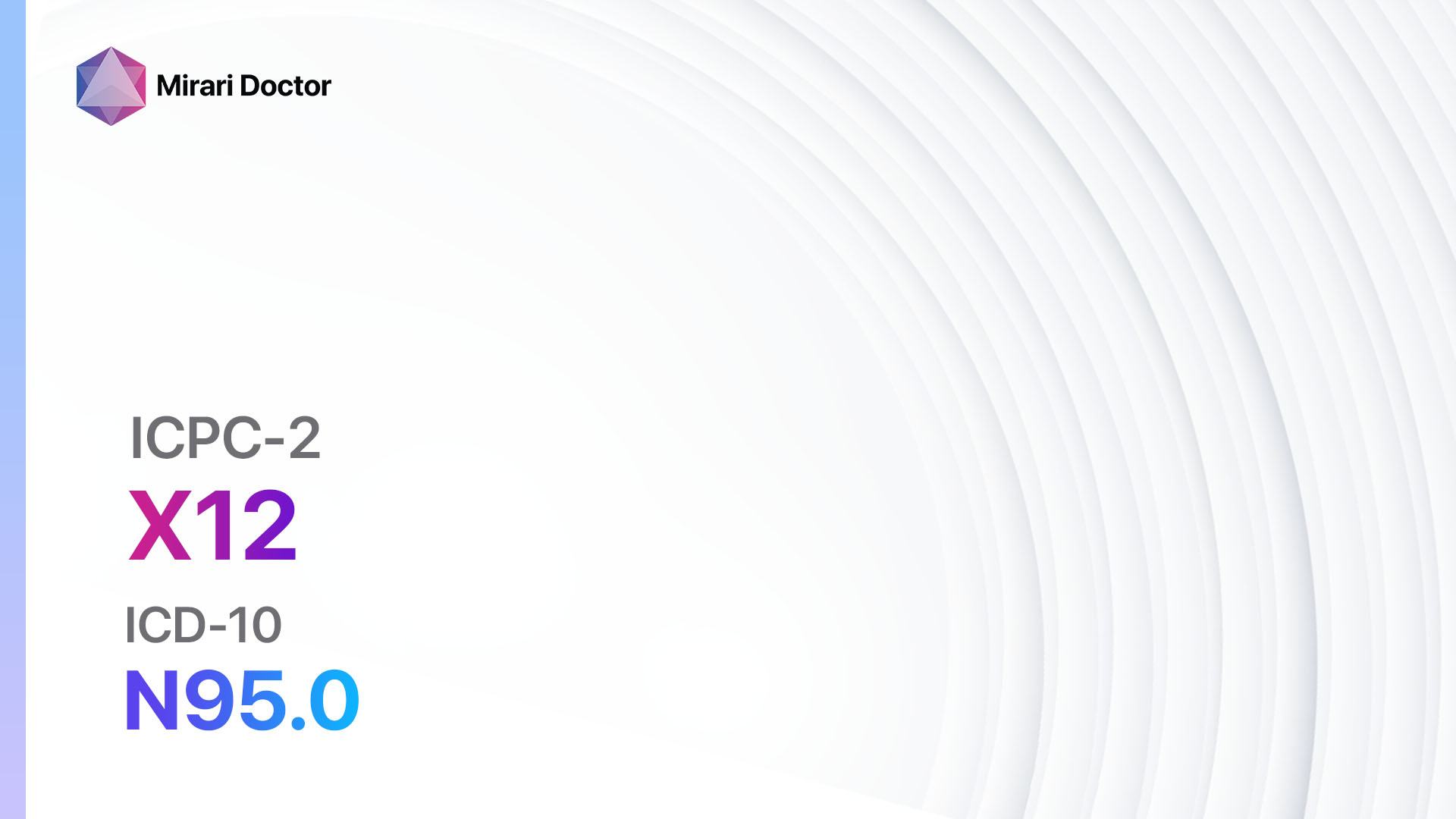
Introduction
Postmenopausal bleeding refers to any vaginal bleeding that occurs after a woman has gone through menopause. Menopause is defined as the absence of menstrual periods for 12 consecutive months[1]. Postmenopausal bleeding can be a concerning symptom as it may indicate underlying health issues, such as hormonal imbalances, endometrial hyperplasia, or even endometrial cancer[2]. The aim of this guide is to provide healthcare professionals with a comprehensive approach to diagnosing and managing postmenopausal bleeding.
Codes
Symptoms
- Vaginal bleeding after menopause
- Spotting or light bleeding between periods[3]
Postmenopausal bleeding is characterized by the following symptoms:
Causes
- Hormonal imbalances
- Endometrial hyperplasia
- Endometrial polyps
- Endometrial atrophy
- Endometrial cancer[4]
The potential causes of postmenopausal bleeding include:
Diagnostic Steps
Medical History
- Gather information about the patient’s menstrual history, including the age at which menopause occurred and the regularity of periods before menopause.
- Ask about any previous episodes of postmenopausal bleeding.
- Inquire about the presence of any other symptoms, such as pelvic pain or discomfort.
- Assess the patient’s risk factors for endometrial cancer, such as obesity, diabetes, and hormone replacement therapy[5].
Physical Examination
- Perform a pelvic examination to assess the condition of the vagina, cervix, and uterus.
- Look for any abnormalities, such as polyps or masses.
- Evaluate the size and shape of the uterus.
- Palpate the ovaries for any signs of enlargement or tenderness[6].
Laboratory Tests
- Complete blood count (CBC) to assess for anemia or other blood disorders.
- Thyroid-stimulating hormone (TSH) test to rule out thyroid dysfunction.
- Coagulation profile to evaluate the patient’s bleeding tendencies.
- Serum hormone levels, including estradiol and follicle-stimulating hormone (FSH), to assess for hormonal imbalances[7].
Diagnostic Imaging
- Transvaginal ultrasound to visualize the thickness of the endometrial lining and detect any abnormalities, such as polyps or fibroids.
- Hysteroscopy, which involves inserting a thin, lighted tube through the cervix to examine the inside of the uterus.
- Endometrial biopsy to obtain a sample of the endometrial tissue for further analysis[8].
Other Tests
- Magnetic resonance imaging (MRI) or computed tomography (CT) scan may be necessary if there is suspicion of advanced disease or to evaluate the extent of spread.
- CA-125 blood test to assess for ovarian cancer in cases where there is suspicion of metastasis[9].
Follow-up and Patient Education
- Schedule a follow-up appointment to discuss the results of the diagnostic tests and determine the appropriate course of treatment.
- Provide the patient with information about the potential causes of postmenopausal bleeding and the importance of early detection and treatment.
- Educate the patient about the signs and symptoms of endometrial cancer and the need for regular check-ups[10].
Possible Interventions
Traditional Interventions
Medications:
Top 5 drugs for Postmenopausal bleeding:
- Hormone replacement therapy (HRT):
- Cost: Varies depending on the specific medication and dosage.
- Contraindications: History of breast cancer, blood clots, or liver disease.
- Side effects: Breast tenderness, bloating, mood swings.
- Severe side effects: Increased risk of breast cancer, blood clots, stroke.
- Drug interactions: Certain medications, such as tamoxifen or aromatase inhibitors, may interfere with the effectiveness of HRT.
- Warning: Long-term use of HRT may increase the risk of certain health conditions.
- Progestin therapy:
- Cost: Varies depending on the specific medication and dosage.
- Contraindications: History of breast cancer, blood clots, or liver disease.
- Side effects: Breast tenderness, bloating, mood swings.
- Severe side effects: Increased risk of breast cancer, blood clots, stroke.
- Drug interactions: Certain medications, such as tamoxifen or aromatase inhibitors, may interfere with the effectiveness of progestin therapy.
- Warning: Long-term use of progestin therapy may increase the risk of certain health conditions.
- Nonsteroidal anti-inflammatory drugs (NSAIDs):
- Cost: Varies depending on the specific medication and dosage.
- Contraindications: History of gastrointestinal bleeding or ulcers, kidney disease.
- Side effects: Upset stomach, heartburn, dizziness.
- Severe side effects: Gastrointestinal bleeding, kidney damage.
- Drug interactions: NSAIDs may interact with certain medications, such as blood thinners or diuretics.
- Warning: Prolonged use of NSAIDs may increase the risk of cardiovascular events.
- Tranexamic acid:
- Cost: Varies depending on the specific medication and dosage.
- Contraindications: History of blood clots, kidney disease.
- Side effects: Upset stomach, headache, muscle pain.
- Severe side effects: Allergic reactions, blood clots.
- Drug interactions: Tranexamic acid may interact with certain medications, such as hormonal contraceptives or anticoagulants.
- Warning: Use with caution in patients with a history of blood clots.
- Gonadotropin-releasing hormone (GnRH) agonists:
- Cost: Varies depending on the specific medication and dosage.
- Contraindications: Pregnancy, breastfeeding, history of osteoporosis.
- Side effects: Hot flashes, vaginal dryness, mood swings.
- Severe side effects: Bone loss, increased risk of fractures.
- Drug interactions: GnRH agonists may interact with certain medications, such as hormonal contraceptives or anticoagulants.
- Warning: Use with caution in patients with a history of osteoporosis.
Alternative Drugs:
- Selective estrogen receptor modulators (SERMs): Medications such as tamoxifen or raloxifene may be used in certain cases to reduce the risk of endometrial cancer.
- Aromatase inhibitors: These medications, such as anastrozole or letrozole, may be used in cases where hormonal imbalances are contributing to postmenopausal bleeding.
- Antifibrinolytic agents: Medications like aminocaproic acid or tranexamic acid may be used to reduce excessive bleeding.
Surgical Procedures:
- Dilation and curettage (D&C): A surgical procedure in which the cervix is dilated and the uterine lining is scraped to remove abnormal tissue. Cost: $3,000 to $7,000.
- Hysterectomy: Surgical removal of the uterus. Cost: $10,000 to $20,000.
Alternative Interventions
- Acupuncture: May help alleviate symptoms and regulate hormonal imbalances. Cost: $60-$120 per session.
- Herbal supplements: Certain herbs, such as black cohosh or red clover, may have potential benefits for managing postmenopausal symptoms. Cost: Varies depending on the specific supplement.
- Mind-body techniques: Practices such as yoga, meditation, or tai chi may help reduce stress and improve overall well-being. Cost: Varies depending on the specific class or program.
- Dietary modifications: Encourage the patient to consume a balanced diet rich in fruits, vegetables, whole grains, and lean proteins. Cost: Varies depending on the patient’s food choices and preferences.
- Exercise: Regular physical activity, such as walking or swimming, can help improve cardiovascular health and reduce the risk of hormonal imbalances. Cost: Varies depending on the patient’s preferred form of exercise.
Lifestyle Interventions
- Maintain a healthy weight: Obesity is a risk factor for hormonal imbalances and endometrial cancer. Encourage the patient to adopt a healthy lifestyle and engage in regular physical activity.
- Avoid smoking and excessive alcohol consumption: Both smoking and alcohol can disrupt hormonal balance and increase the risk of endometrial cancer.
- Manage stress: Chronic stress can contribute to hormonal imbalances. Encourage the patient to engage in stress-reducing activities, such as meditation or yoga.
- Regular check-ups: Emphasize the importance of regular gynecological check-ups to monitor for any changes or abnormalities.
It is important to note that the cost ranges provided are approximate and may vary depending on the location and availability of the interventions.
Mirari Cold Plasma Alternative Intervention
Understanding Mirari Cold Plasma
- Safe and Non-Invasive Treatment: Mirari Cold Plasma is a safe and non-invasive treatment option for various skin conditions. It does not require incisions, minimizing the risk of scarring, bleeding, or tissue damage.
- Efficient Extraction of Foreign Bodies: Mirari Cold Plasma facilitates the removal of foreign bodies from the skin by degrading and dissociating organic matter, allowing easier access and extraction.
- Pain Reduction and Comfort: Mirari Cold Plasma has a local analgesic effect, providing pain relief during the treatment, making it more comfortable for the patient.
- Reduced Risk of Infection: Mirari Cold Plasma has antimicrobial properties, effectively killing bacteria and reducing the risk of infection.
- Accelerated Healing and Minimal Scarring: Mirari Cold Plasma stimulates wound healing and tissue regeneration, reducing healing time and minimizing the formation of scars.
Mirari Cold Plasma Prescription
Video instructions for using Mirari Cold Plasma Device – X12 Postmenopausal bleeding (ICD-10:N95.0)
| Mild | Moderate | Severe |
| Mode setting: 1 (Infection) Location: 2 (Prostate & Uterus) Morning: 15 minutes, Evening: 15 minutes |
Mode setting: 1 (Infection) Location: 2 (Prostate & Uterus) Morning: 30 minutes, Lunch: 30 minutes, Evening: 30 minutes |
Mode setting: 1 (Infection) Location: 2 (Prostate & Uterus) Morning: 30 minutes, Lunch: 30 minutes, Evening: 30 minutes |
| Mode setting: 2 (Wound Healing) Location: 2 (Prostate & Uterus) Morning: 15 minutes, Evening: 15 minutes |
Mode setting: 2 (Wound Healing) Location: 2 (Prostate & Uterus) Morning: 30 minutes, Lunch: 30 minutes, Evening: 30 minutes |
Mode setting: 2 (Wound Healing) Location: 2 (Prostate & Uterus) Morning: 30 minutes, Lunch: 30 minutes, Evening: 30 minutes |
| Mode setting: 8 (Insomnia) Location: 7 (Neuro system & ENT) Morning: 15 minutes, Evening: 15 minutes |
Mode setting: 8 (Insomnia) Location: 7 (Neuro system & ENT) Morning: 30 minutes, Lunch: 30 minutes, Evening: 30 minutes |
Mode setting: 8 (Insomnia) Location: 7 (Neuro system & ENT) Morning: 30 minutes, Lunch: 30 minutes, Evening: 30 minutes |
| Total Morning: 45 minutes approx. $7.50 USD, Evening: 45 minutes approx. $7.50 USD |
Total Morning: 90 minutes approx. $15 USD, Lunch: 90 minutes approx. $15 USD, Evening: 90 minutes approx. $15 USD, |
Total Morning: 90 minutes approx. $15 USD, Lunch: 90 minutes approx. $15 USD, Evening: 90 minutes approx. $15 USD, |
| Usual treatment for 7-60 days approx. $105 USD – $900 USD | Usual treatment for 6-8 weeks approx. $1,890 USD – $2,520 USD |
Usual treatment for 3-6 months approx. $4,050 USD – $8,100 USD
|
 |
|
Use the Mirari Cold Plasma device to treat Postmenopausal bleeding effectively.
WARNING: MIRARI COLD PLASMA IS DESIGNED FOR THE HUMAN BODY WITHOUT ANY ARTIFICIAL OR THIRD PARTY PRODUCTS. USE OF OTHER PRODUCTS IN COMBINATION WITH MIRARI COLD PLASMA MAY CAUSE UNPREDICTABLE EFFECTS, HARM OR INJURY. PLEASE CONSULT A MEDICAL PROFESSIONAL BEFORE COMBINING ANY OTHER PRODUCTS WITH USE OF MIRARI.
Step 1: Cleanse the Skin
- Start by cleaning the affected area of the skin with a gentle cleanser or mild soap and water. Gently pat the area dry with a clean towel.
Step 2: Prepare the Mirari Cold Plasma device
- Ensure that the Mirari Cold Plasma device is fully charged or has fresh batteries as per the manufacturer’s instructions. Make sure the device is clean and in good working condition.
- Switch on the Mirari device using the power button or by following the specific instructions provided with the device.
- Some Mirari devices may have adjustable settings for intensity or treatment duration. Follow the manufacturer’s instructions to select the appropriate settings based on your needs and the recommended guidelines.
Step 3: Apply the Device
- Place the Mirari device in direct contact with the affected area of the skin. Gently glide or hold the device over the skin surface, ensuring even coverage of the area experiencing.
- Slowly move the Mirari device in a circular motion or follow a specific pattern as indicated in the user manual. This helps ensure thorough treatment coverage.
Step 4: Monitor and Assess:
- Keep track of your progress and evaluate the effectiveness of the Mirari device in managing your Postmenopausal bleeding. If you have any concerns or notice any adverse reactions, consult with your health care professional.
Note
This guide is for informational purposes only and should not replace the advice of a medical professional. Always consult with your healthcare provider or a qualified medical professional for personal advice, diagnosis, or treatment. Do not solely rely on the information presented here for decisions about your health. Use of this information is at your own risk. The authors of this guide, nor any associated entities or platforms, are not responsible for any potential adverse effects or outcomes based on the content.
Mirari Cold Plasma System Disclaimer
- Purpose: The Mirari Cold Plasma System is a Class 2 medical device designed for use by trained healthcare professionals. It is registered for use in Thailand and Vietnam. It is not intended for use outside of these locations.
- Informational Use: The content and information provided with the device are for educational and informational purposes only. They are not a substitute for professional medical advice or care.
- Variable Outcomes: While the device is approved for specific uses, individual outcomes can differ. We do not assert or guarantee specific medical outcomes.
- Consultation: Prior to utilizing the device or making decisions based on its content, it is essential to consult with a Certified Mirari Tele-Therapist and your medical healthcare provider regarding specific protocols.
- Liability: By using this device, users are acknowledging and accepting all potential risks. Neither the manufacturer nor the distributor will be held accountable for any adverse reactions, injuries, or damages stemming from its use.
- Geographical Availability: This device has received approval for designated purposes by the Thai and Vietnam FDA. As of now, outside of Thailand and Vietnam, the Mirari Cold Plasma System is not available for purchase or use.
References
- Mayo Clinic. (2023). Menopause – Symptoms and causes. Retrieved from https://www.mayoclinic.org/diseases-conditions/menopause/symptoms-causes/syc-20353397
- American College of Obstetricians and Gynecologists. (2023). The Menopause Years. Retrieved from https://www.acog.org/womens-health/faqs/the-menopause-years
- National Institute on Aging. (2023). What Is Menopause? Retrieved from https://www.nia.nih.gov/health/menopause/what-menopause
- Clarke, M. A., Long, B. J., Del Mar Morillo, A., Arbyn, M., Bakkum-Gamez, J. N., & Wentzensen, N. (2018). Association of Endometrial Cancer Risk With Postmenopausal Bleeding in Women: A Systematic Review and Meta-analysis. JAMA Internal Medicine, 178(9), 1210-1222.
- American College of Obstetricians and Gynecologists. (2018). ACOG Committee Opinion No. 734: The Role of Transvaginal Ultrasonography in Evaluating the Endometrium of Women With Postmenopausal Bleeding. Obstetrics & Gynecology, 131(5), e124-e129.
- Munro, M. G., Critchley, H. O., & Fraser, I. S. (2011). The FIGO classification of causes of abnormal uterine bleeding in the reproductive years. Fertility and Sterility, 95(7), 2204-2208.
- Burbos, N., Musonda, P., Giarenis, I., Shiner, A. M., Giamougiannis, P., Morris, E. P., & Nieto, J. J. (2010). Predicting the risk of endometrial cancer in postmenopausal women presenting with vaginal bleeding: the Norwich DEFAB risk assessment tool. British Journal of Cancer, 102(8), 1201-1206.
- Smith-Bindman, R., Weiss, E., & Feldstein, V. (2004). How thick is too thick? When endometrial thickness should prompt biopsy in postmenopausal women without vaginal bleeding. Ultrasound in Obstetrics and Gynecology, 24(5), 558-565.
- Jacobs, I., Gentry-Maharaj, A., Burnell, M., Manchanda, R., Singh, N., Sharma, A., … & Menon, U. (2011). Sensitivity of transvaginal ultrasound screening for endometrial cancer in postmenopausal women: a case-control study within the UKCTOCS cohort. The Lancet Oncology, 12(1), 38-48.
- American Cancer Society. (2023). Endometrial Cancer Early Detection, Diagnosis, and Staging. Retrieved from https://www.cancer.org/cancer/endometrial-cancer/detection-diagnosis-staging.html
Related articles
Made in USA




